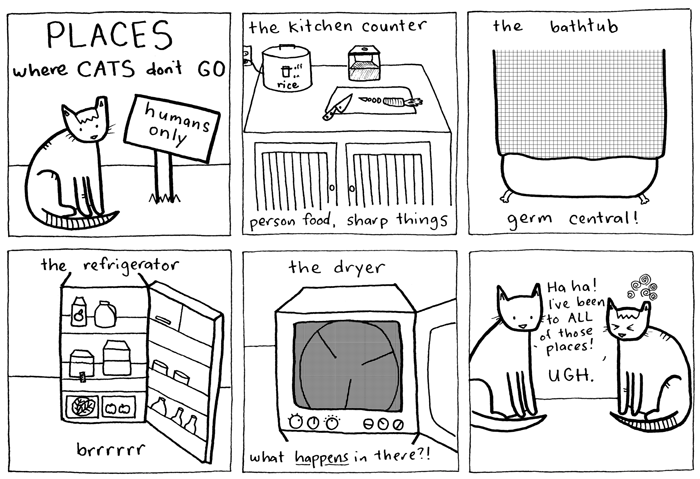Journal comics! There are a lot of them out there. When done well, a journal comic can highlight familiar experiences or give expression to something that the reader understands but has never thought to elucidate. The author may find the humor in everyday life, prompting the audience to delight in otherwise mundane tasks, or just to feel a sense of camaraderie, knowing that other people share those experiences, even if few ever voice them.
Another use of journal comics can be to illustrate the experiences of someone who shares little with the audience. Little-understood cultures or professions may be illuminated, helping the world to become more connected through the art of self-expression.
Today we’ll be talking about a journal comic that achieves the latter, by illustrating the experiences of someone who is not even human. Welcome to the world’s only journal comic written and drawn by a real-life cat: Hey Pais.
Hey Pais lets us in on the daily life of an ordinary the prettiest cat, Pais (short for Paisley). She keeps us up to date on the goings-on of her catnip mice, the humans she lives with, and important news of the feline world. It’s a pretty simple premise, but it’s tackled with a level of dedication and sincerity (of a sort) that make it engaging.
Humans who’ve lived with cats before will find some familiarity in these comics. Pais behaves in many ways as other cats do, prompting us humans to shrug and laugh and chalk up the behavior to just more crazy cat antics. By reading Hey Pais, we humans can gain some insight into a cat’s perspective on these antics. Pais understands her own behavior, and she lays it out in such a way that it’s obvious why she behaves the way she does. It’s taken for granted that this behavior makes sense; the assumptions tend to go unstated, but it’s easy to tell what it is we are meant to be assuming.
Sometimes Hey Pais provides cool cat facts! These tidbits are useful for cat owners, and fascinating for those out there who don’t have direct experience with cats. Some of the cat stereotypes you’ve likely heard are incorrect, or self-contradictory. Hey Pais does its part to spread understanding and awareness.
Not all cats are alike. Hey Pais provides one cat’s perspective, and as any cat owner is aware, every single cat is a precious snowflake with notable distinctions separating him or her from every other cat in appearance and personality.
Each author can only truly trust themselves to represent their own perspective. Empathising with others is a useful quality, but it can be difficult to truly put yourself in another person’s mindset, especially if your own life experience is somewhat limited. Pais spends most of her life in the same home, seeing a limited handful of people, and encounters few things that challenge her worldview.
When a second cat moves in, we get a useful shaking-up of the status quo, and get to see first-hand some of the ways that Pais’ experiences of normality do not necessarily extend to all cats.
(The arrival of the boy cat Boo Radley would be a spoiler, but since this is a journal comic depicting things that happened in real life, the application of the concept of spoilers doesn’t make sense.)
If you read Hey Pais, you’ll get to learn more about what it’s like to be a cat, through one individual cat’s perspective on the world around her. There are recognizable behaviors, the kind that spark a feeling of amused familiarity, along with some unique tendencies that are all Pais. It’s a lighthearted and fun way to get a feeling of a completely different perspective to the one you’re used to, i.e., that of a human.
So if you like cats, or you just feel like expanding your narrow personal horizons a little bit by empathizing with a member of a different species, check it out!
Hey Pais is written and drawn by Sara Bauer Paisley Paiserton and updates irregularly. I like to check back every month or so and see if there’s anything new.
You don’t have to read Hey Pais in order, though there are some recurring terms that make more sense if you read the comics where they’re first introduced. For example, above, “loafhacker” is a pun on “lifehacker” (which you probably got) and the term “loafing” for the way that cats lie around the house (which you may not have realized). Plus, the archive is a pretty quick read, so if you’re in the mood to read the whole thing I’d recommend it. Mostly, though, it’s easy to catch on so if you’d rather just jump in with any old comic feel free.
Next Entry: Chainsawsuit






















